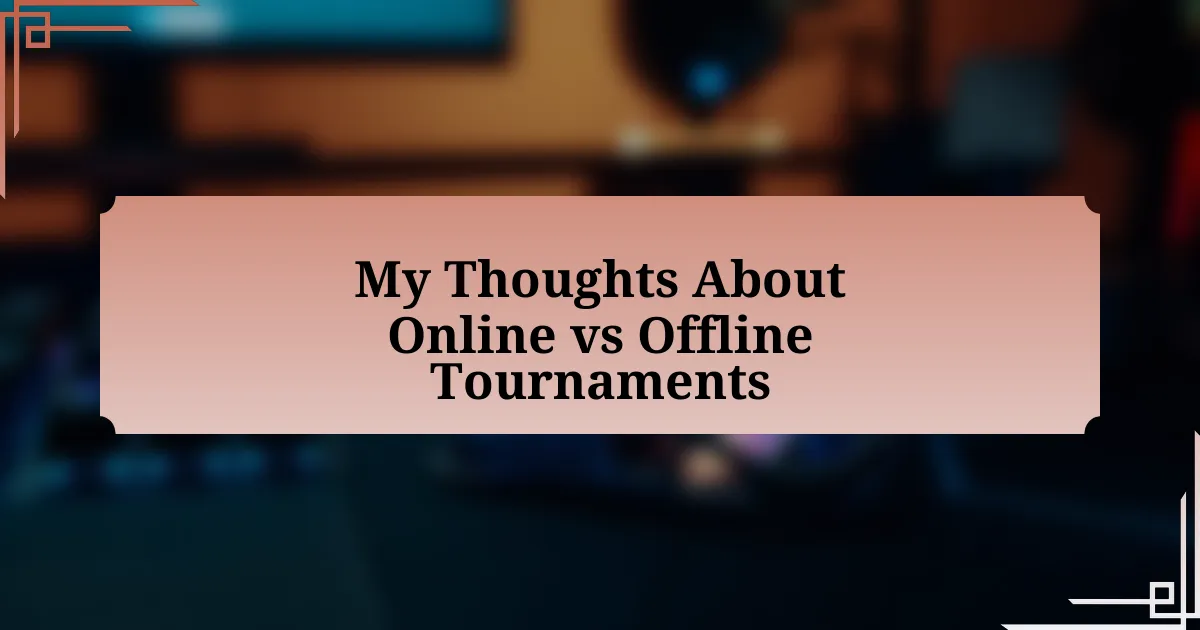Key takeaways:
- eSports tournaments have gained immense popularity, with distinct experiences in online and offline formats.
- Online tournaments offer accessibility and flexibility, allowing global participation, while offline tournaments create a vibrant atmosphere and foster deep player connections.
- Technical issues in online play can disrupt gameplay, whereas stable offline environments enhance player focus and performance.
- Both formats provide unique advantages, with the online offering convenience and cost-effectiveness, and offline providing community engagement and better infrastructure.
Author: Evelyn Hartley
Bio: Evelyn Hartley is an award-winning author known for her compelling narratives and richly drawn characters. With a background in psychology and literature, she weaves intricate tales that explore the complexities of human relationships and the intricacies of the human psyche. Her debut novel, “Whispers in the Dark,” was celebrated by critics and readers alike, earning her a dedicated following. Evelyn’s work has been featured in various literary journals and anthologies, and she frequently speaks at writing conferences and workshops. When she’s not writing, she enjoys hiking in the mountains and volunteering at her local animal shelter. She resides in Seattle with her two rescue dogs, Luna and Milo.

Overview of eSports tournaments
eSports tournaments have exploded in popularity over the past decade, evolving into massive events that draw thousands of fans and players alike. I still remember my first experience watching a live tournament; the energy in the arena was palpable. There’s something truly electric about being among fellow fans, cheering for your favorite teams, and witnessing the skillful plays unfold right before your eyes.
There are two main types of tournaments: online and offline, each offering unique experiences and challenges. I often ponder which format feels more authentic. While online tournaments provide unprecedented access and convenience, there’s a certain charm to the atmosphere of a live event that captures the deep emotional investment of both players and fans. Have you ever felt the adrenaline rush of being in a crowd during a dramatic climax of a match?
As the scene continues to grow, the structure of tournaments varies widely, from grassroots competitions to high-stakes championships with million-dollar prize pools. I’ve seen how the scale influences player performance and strategy. It makes me wonder how different the pressure must be when competing before thousands of spectators versus a webcam. The disparity between these environments is not just a logistical challenge; it shapes the narrative of the tournament itself, impacting every participant’s journey.
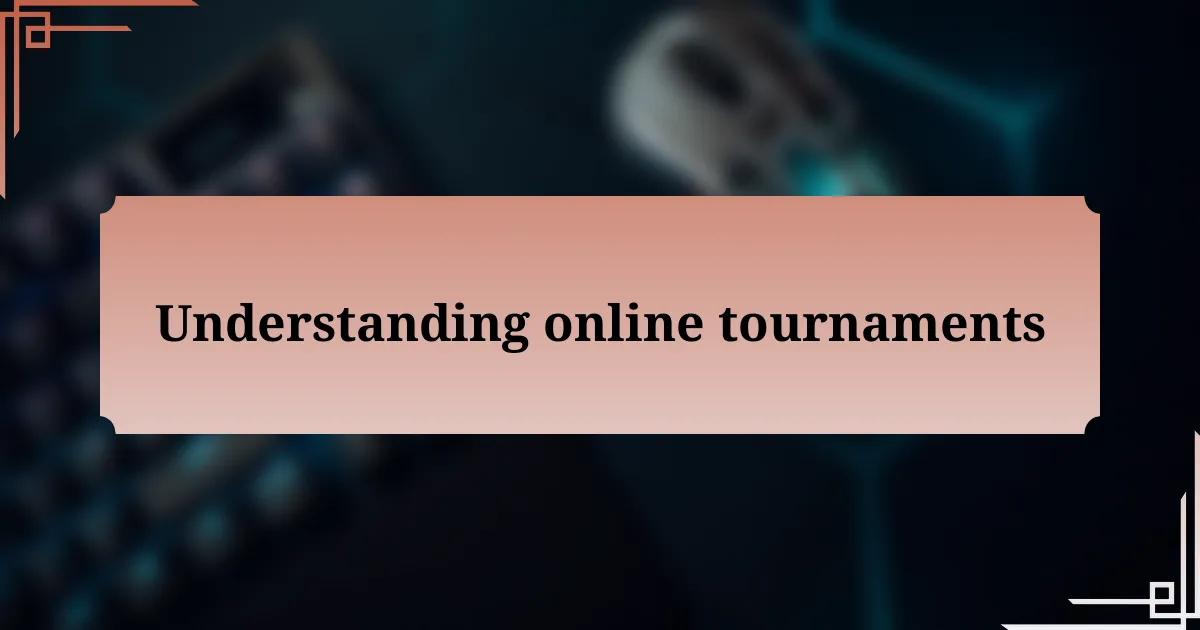
Understanding online tournaments
Understanding online tournaments brings an entirely different dynamic to the gaming landscape. I remember participating in an online tournament for a popular game and the thrill of competing from the comfort of my home. The convenience of logging in and instantly being part of a global arena is something that truly sets online tournaments apart.
One aspect that continually intrigues me is the accessibility of these events. Players from around the world can join with just a few clicks. Have you ever considered how this creates a diverse pool of competitors, each bringing unique strategies and styles? I find it fascinating to watch how different playstyles emerge based on regional trends and preferences, enriching the competitive experience.
Yet, online tournaments often pose challenges that can’t be ignored. Technical issues can turn the tide of a match in an instant. I once faced a frustrating lag that cost my team crucial points, making me realize how much vulnerability we have in the digital realm. These experiences highlight the delicate balance between convenience and the unpredictable nature of online play, shaping our perceptions of what it means to compete effectively in the eSports arena.
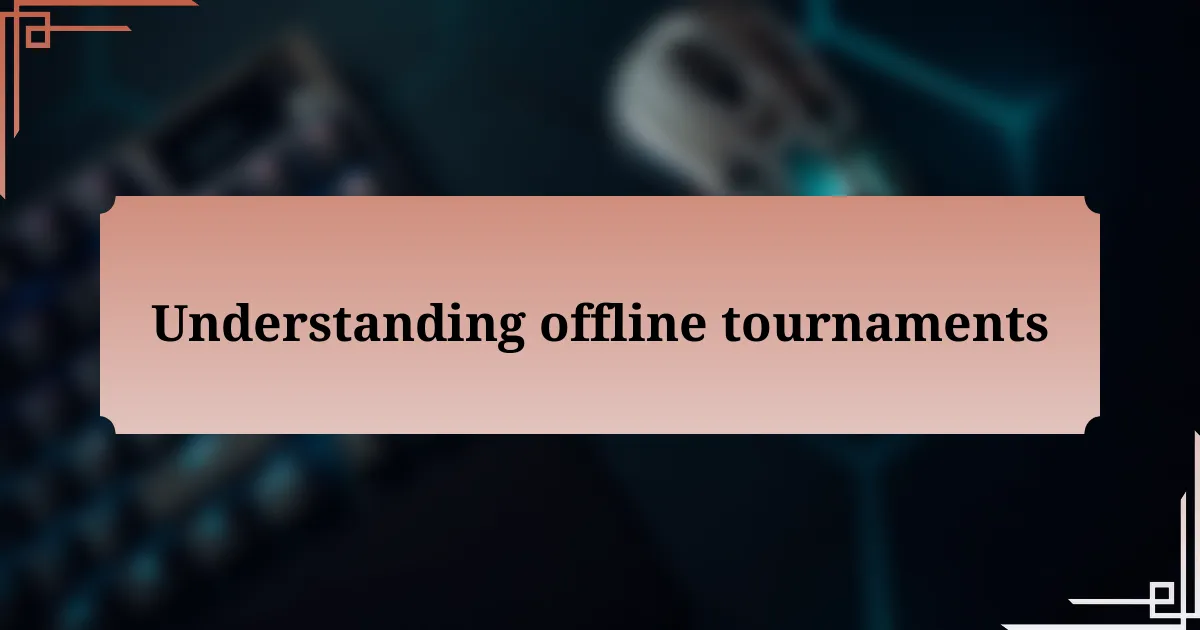
Understanding offline tournaments
Offline tournaments offer a unique atmosphere that online competitions simply can’t replicate. I had the chance to attend a major eSports event in person, and the buzz in the air was palpable. The excitement of being surrounded by passionate fans, cheering and chanting for their favorite players, created an energy that was infectious and unforgettable.
Competing in offline tournaments also brings a sense of camaraderie. I recall practicing with my team late into the night leading up to a live event, strategizing and bonding over our shared goal. Have you ever felt that surge of adrenaline when you step onto a stage, with thousands of eyes watching? The pressure is immense, but so is the thrill of performing in front of a live audience.
Moreover, the challenges of offline tournaments push players to adapt rapidly. When I faced a formidable opponent live, I had to read their movements in real-time, which required a level of focus that online play doesn’t always demand. This heightened awareness and adjustment sharpen skills and foster growth, illustrating how offline competition can elevate a player’s game in ways that virtual matches might leave unexplored.
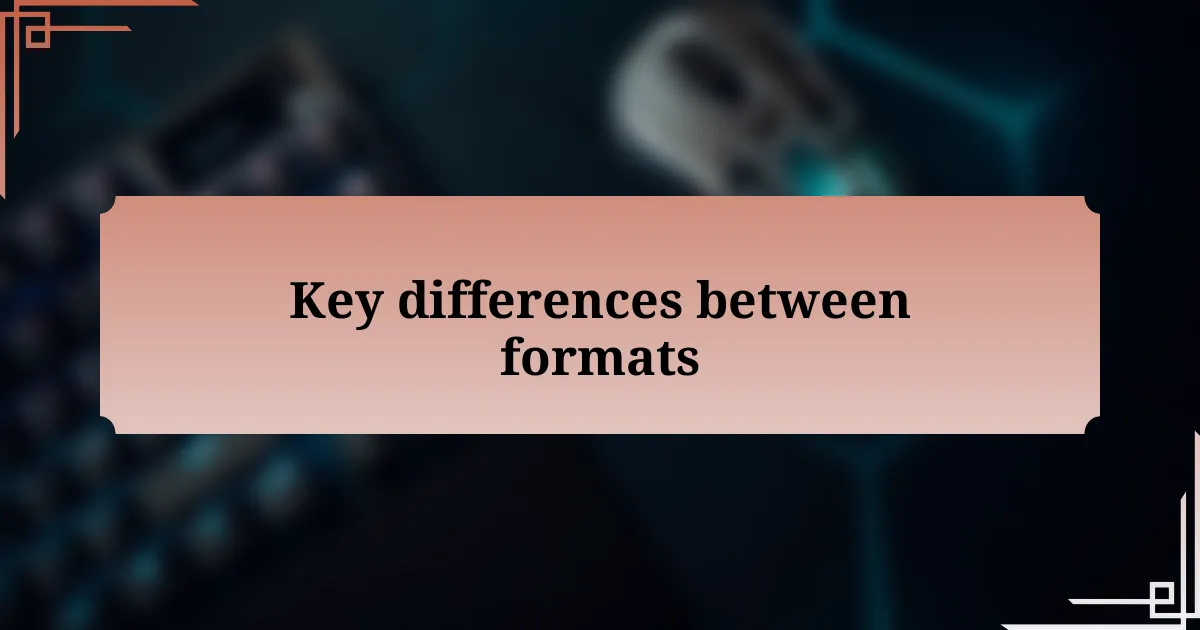
Key differences between formats
The key differences between online and offline tournaments primarily stem from the overall experience each format provides. In offline events, the immediate feedback from a live audience can heavily influence a player’s performance. Reflecting on my own experience, when I scored a crucial point during a live match, the roar of the crowd sent chills down my spine. Can you imagine feeling that energy as you battle for victory?
Another significant difference lies in the technical aspects of gameplay. Online tournaments often face issues like lag or connectivity problems, which can disrupt strategy execution. I’ve seen skilled players struggle when their internet connection failed right before an important match. In contrast, the stable environment of an offline venue minimizes these risks, allowing players to focus solely on their skills.
Finally, the format of team dynamics plays a pivotal role. Offline tournaments encourage more face-to-face communication, which can build stronger bonds within teams. I remember discussing strategies after matches with my teammates, fueling our chemistry and enhancing our gameplay. How often do you take such deep conversations online, where distractions can pull focus away? The intimacy of offline settings often leads to more effective teamwork, making a big difference when it counts.
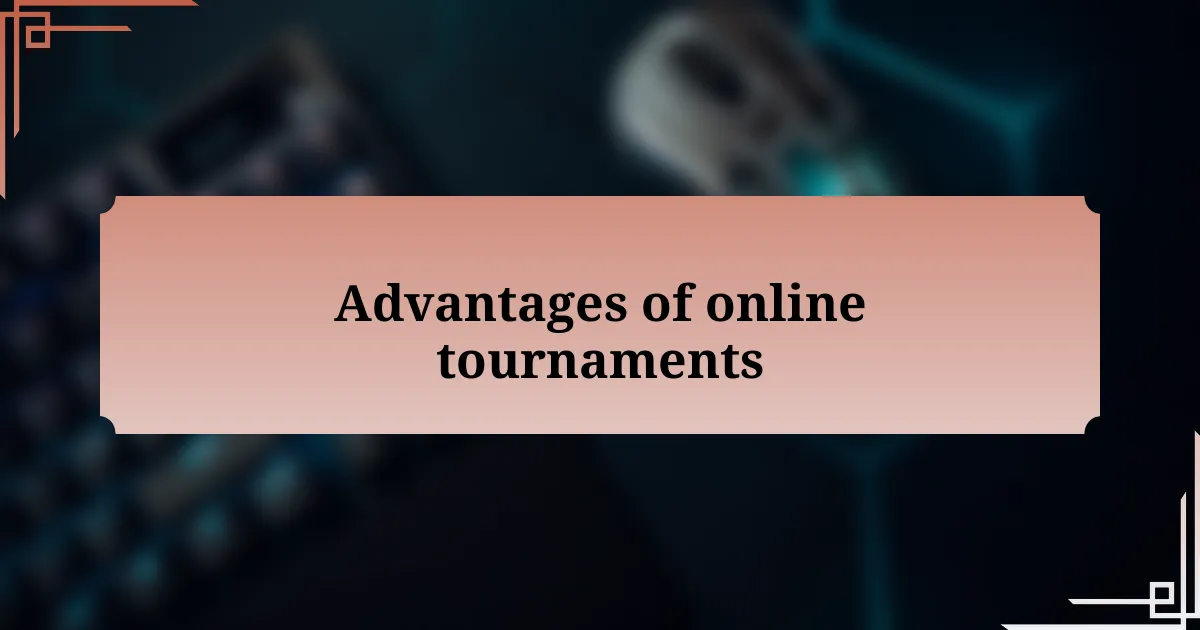
Advantages of online tournaments
Online tournaments offer a level of accessibility that is hard to beat. Players from different parts of the world can compete without having to travel to a specific location. I remember the excitement I felt when I could easily join a global tournament from my favorite gaming setup at home, bringing together diverse talents without geographical barriers. Have you ever thought about how this opens the door for newcomers to experience competitive play?
Another significant benefit is the flexibility of scheduling. Players can participate in online competitions at times that suit them best, rather than adhering to rigid tournament schedules. I’ve often appreciated being able to fit matches around my daily commitments. It creates an environment where you can focus on performing at your best, rather than feeling rushed or stressed. Isn’t it nice to play when you feel most ready?
Finally, online tournaments usually have lower entry fees and logistical costs. This accessibility means that more players can participate, increasing the competition level. Reflecting on some of my favorite online events, I saw incredible talent emerging from players who might not have been able to afford the travel or admission costs associated with offline tournaments. Isn’t it thrilling to discover fresh skills and strategies from diverse participants you wouldn’t encounter otherwise?
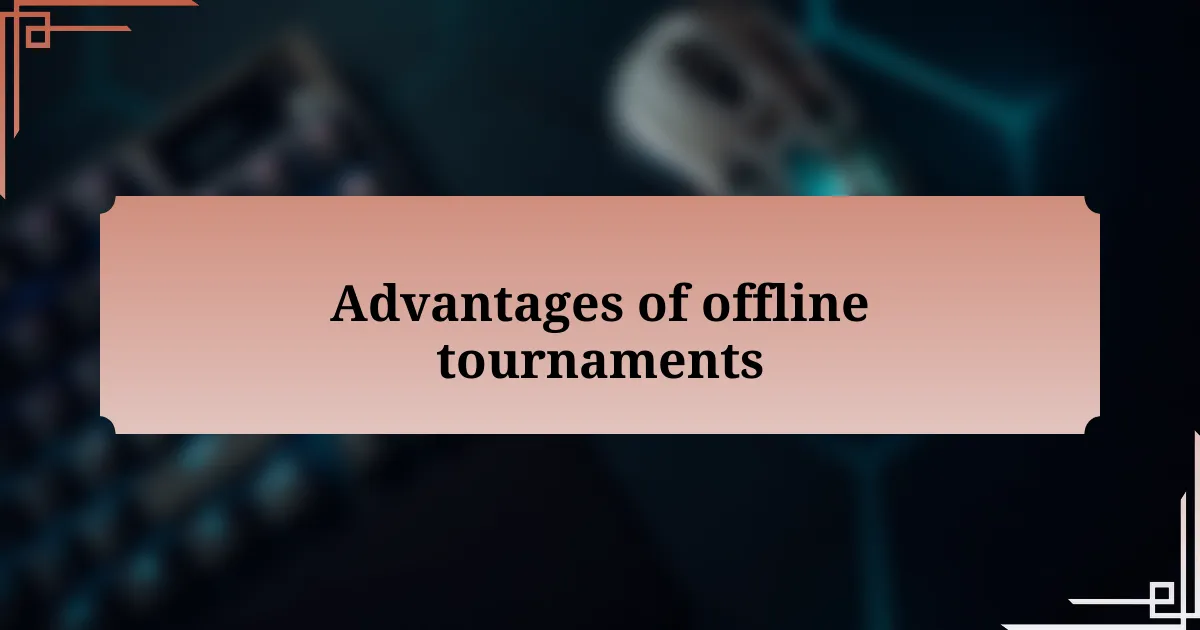
Advantages of offline tournaments
Offline tournaments have a unique atmosphere that online events simply can’t replicate. There’s an undeniable energy in a live venue, where players and fans come together, cheering and celebrating every impressive play. I vividly remember the rush of standing among fellow spectators, feeling the adrenaline building as the competition heated up. Doesn’t that sense of community and shared excitement make the experience even more thrilling?
Another advantage is the opportunity for face-to-face interactions. Players can connect with each other more deeply, forming friendships and rivalries that go beyond the screen. I’ve seen countless players form teams and alliances based on those personal interactions, which can greatly enhance their competitive experience. How often do you find that kind of genuine connection in the online gaming world?
Moreover, offline tournaments often have better infrastructure and support. With professional setups, technical assistance, and a dedicated audience, everything runs smoother compared to the unpredictability of online connectivity issues. I can recall a tournament where everything went perfectly—from the streaming quality to the match organization. It was a reminder that the environment can significantly impact performance. Isn’t it comforting to know that when you step onto that stage, everything is in place to showcase your skills?
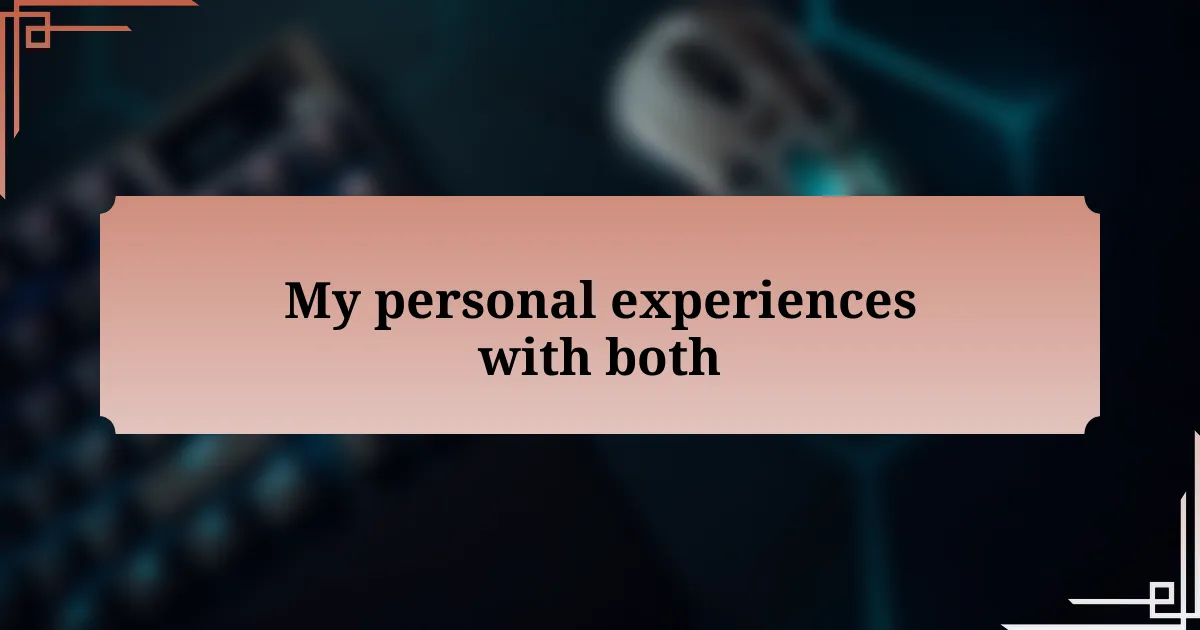
My personal experiences with both
Experiencing online tournaments has its own charm and convenience. I recall participating in one late at night when my friends and I gathered on voice chat, all of us sporting our favorite snacks. The thrill of strategizing from our own homes felt liberating, but I couldn’t help but miss the palpable energy of an in-person event. Isn’t it interesting how the excitement shifts when you’re only a screen away from your competitors?
There was an online tournament where I faced off against some tough opponents. While I enjoyed the comfort of my setup, there were moments of frustration when lag disrupted the flow of gameplay. Unlike the seamless experience of offline tournaments, the unpredictability of internet connectivity can sometimes turn an intense competition into an uncertain ordeal. Have you ever been in the middle of a critical match, only to feel that sinking feeling when the connection drops?
Balancing both types of tournaments has taught me valuable lessons. The strategic planning involved in online games—calculating the optimal moment to jump into a match from the comfort of my chair—has its own advantages. Yet, nothing can quite compare to the thrill of standing shoulder to shoulder with fellow gamers, sharing in the electric atmosphere of live competitions. Doesn’t it make you wonder which format truly delivers the best experience for competitive gaming?

